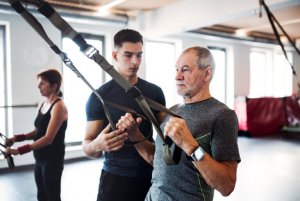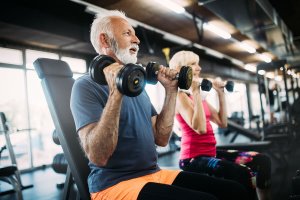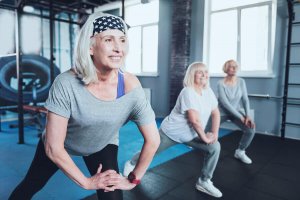How to Increase Strength in Elderly People

Increasing strength in elderly people can be one of the greatest challenges for trainers. Both older adults and trainers need to work hard to have good results.
The body requires constant exercise to stay healthy, regardless of how old you are. However, upon reaching old age, there should be even more supervision.
Becoming older should not be synonymous with physical inactivity. Lots of people think that by reaching 60 years old or more, you should be more sedentary. However, that can only cause problems for your body.
Do elderly people need to get stronger?
As we mentioned earlier, no matter what stage of life you’re in, increasing strength is extremely important. When you’re an older adult, strength is important in daily life. From a wheelchair ride to standing up to go to the bathroom requires strength.
Therefore, increasing strength or finding a way to maintain it becomes a primary goal of everyday life. In this article, we’ll see how elderly people can increase their strength appropriately. Keep reading to learn about it!
Strength as a physical ability
To understand the importance of increasing strength, we first need to know what it is. Strength is a conditional physical ability focused on building muscle tension versus resistance.

By developing strength, it’s easier for the body to do certain activities: lifting objects, throwing them, dragging them, moving them, and more. The heavier something is, the stronger you need to be. Basically, this is why it’s important to be strong.
However, to improve it, it’s necessary to distinguish the types of force that exist: isotonic and isometric.
- Isotonic contraction: also known as a dynamic force, because the muscles are activated by resistance to moving an object.
- Isometric contraction: as opposed to isotonic, muscles exert force but not to move an object. In this case, it’s also known as static force.
How to increase strength in elderly people
A high percentage of elderly people don’t perform physical activity, either due to ignorance or laziness. The task for trainers, caregivers, or relatives in charge is to encourage exercise.
Although elderly people should work on all physical abilities, we’re focusing on increasing strength here. To do so, we’ll show you a few keys.
Physical exercise routine
During long periods of physical inactivity, muscle atrophy may appear, which is the wasting or loss of muscle tissue.
However, you can fight against this through regular physical activity. Making an exercise routine to increase strength is the main recommendation for elderly people.
To do these exercises, it’s necessary to meet a team of professionals to create a training plan according to the needs of each person. The strength routine must consider the physical capacities, physical and psychological conditions, the environment, gender, and more.

Make physical activity important
Practices such as walking, sitting, dancing or others that use energy in daily life will probably be more important. Although these are common physical activities, they can help increase elderly peoples’ strength. Including these types of physical activity in your training plans can be very helpful.
Don’t forget about diet
No matter how elaborate the training plan or schedule is, if you don’t consider the diet, the exercise doesn’t matter. Diet is the main fuel for the body, which is why you can’t forget about it.
At this point, nutritionists are very important. Also, just as you need a training plan, to increase strength, you need to build a food plan.
Increase strength in elderly people: conclusion
Being too specific about improving physical ability like strength can backfire. Therefore, we recommend that you consider these tips while working with a nutritionist and a trainer. If you become stronger, your quality of life will surely increase!
Increasing strength in elderly people can be one of the greatest challenges for trainers. Both older adults and trainers need to work hard to have good results.
The body requires constant exercise to stay healthy, regardless of how old you are. However, upon reaching old age, there should be even more supervision.
Becoming older should not be synonymous with physical inactivity. Lots of people think that by reaching 60 years old or more, you should be more sedentary. However, that can only cause problems for your body.
Do elderly people need to get stronger?
As we mentioned earlier, no matter what stage of life you’re in, increasing strength is extremely important. When you’re an older adult, strength is important in daily life. From a wheelchair ride to standing up to go to the bathroom requires strength.
Therefore, increasing strength or finding a way to maintain it becomes a primary goal of everyday life. In this article, we’ll see how elderly people can increase their strength appropriately. Keep reading to learn about it!
Strength as a physical ability
To understand the importance of increasing strength, we first need to know what it is. Strength is a conditional physical ability focused on building muscle tension versus resistance.

By developing strength, it’s easier for the body to do certain activities: lifting objects, throwing them, dragging them, moving them, and more. The heavier something is, the stronger you need to be. Basically, this is why it’s important to be strong.
However, to improve it, it’s necessary to distinguish the types of force that exist: isotonic and isometric.
- Isotonic contraction: also known as a dynamic force, because the muscles are activated by resistance to moving an object.
- Isometric contraction: as opposed to isotonic, muscles exert force but not to move an object. In this case, it’s also known as static force.
How to increase strength in elderly people
A high percentage of elderly people don’t perform physical activity, either due to ignorance or laziness. The task for trainers, caregivers, or relatives in charge is to encourage exercise.
Although elderly people should work on all physical abilities, we’re focusing on increasing strength here. To do so, we’ll show you a few keys.
Physical exercise routine
During long periods of physical inactivity, muscle atrophy may appear, which is the wasting or loss of muscle tissue.
However, you can fight against this through regular physical activity. Making an exercise routine to increase strength is the main recommendation for elderly people.
To do these exercises, it’s necessary to meet a team of professionals to create a training plan according to the needs of each person. The strength routine must consider the physical capacities, physical and psychological conditions, the environment, gender, and more.

Make physical activity important
Practices such as walking, sitting, dancing or others that use energy in daily life will probably be more important. Although these are common physical activities, they can help increase elderly peoples’ strength. Including these types of physical activity in your training plans can be very helpful.
Don’t forget about diet
No matter how elaborate the training plan or schedule is, if you don’t consider the diet, the exercise doesn’t matter. Diet is the main fuel for the body, which is why you can’t forget about it.
At this point, nutritionists are very important. Also, just as you need a training plan, to increase strength, you need to build a food plan.
Increase strength in elderly people: conclusion
Being too specific about improving physical ability like strength can backfire. Therefore, we recommend that you consider these tips while working with a nutritionist and a trainer. If you become stronger, your quality of life will surely increase!
All cited sources were thoroughly reviewed by our team to ensure their quality, reliability, currency, and validity. The bibliography of this article was considered reliable and of academic or scientific accuracy.
- Chalapud Narváez, L. M., & Escobar Almario, A. E. (2017). Actividad física para mejorar fuerza y equilibrio en el adulto mayor. Universidad y Salud. https://doi.org/10.22267/rus.171901.73
- Limón, M. R., & Ortega, M. del C. (2011). Envejecimiento activo y mejora de la calidad de vida en adultos mayores. Revista de Psicología y Educación.
- Ministerio De Educación y Ciencia, & Ministerio De Sanidad y Consumo. (2010). Conceptos importantes en materia de Actividad Física y de Condición Física. Actividad Física y Salud En La Infancia y La Adolescencia.
- Moreno González, A. (2005). Incidencia de la Actividad Física en el adulto mayor. Revista Internacional de Medicina y Ciencias de La Actividad Física y Del Deporte.
This text is provided for informational purposes only and does not replace consultation with a professional. If in doubt, consult your specialist.








